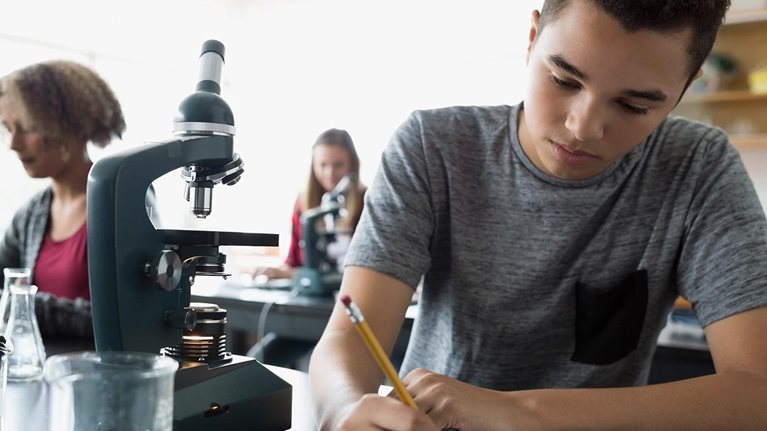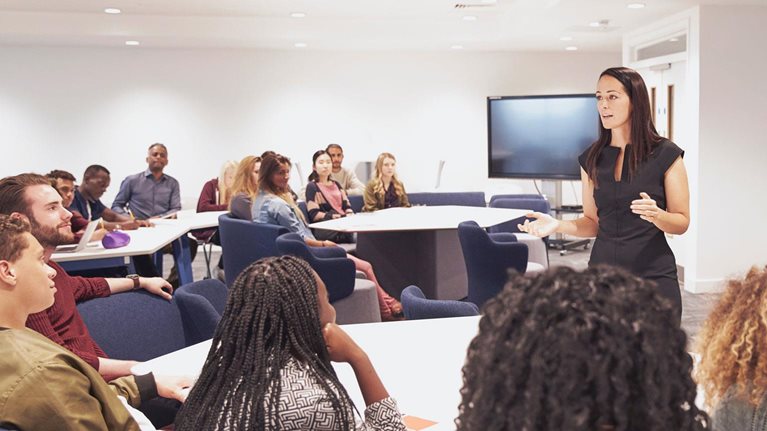The teaching profession is under siege. Working hours for teachers are increasing as student needs become more complex and administrative and paperwork burdens increase. According to a recent McKinsey survey, conducted in a research partnership with Microsoft, teachers are working an average of 50 hours a week1—a number that the Organisation for Economic Co-operation and Development Teaching and Learning International Survey suggests has increased by 3 percent over the past five years.2
While most teachers report enjoying their work, they do not report enjoying the late nights marking papers, preparing lesson plans, or filling out endless paperwork. Burnout and high attrition rates are testaments to the very real pressures on teachers. In the neediest schools in the United States, for example, teacher turnover tops 16 percent per annum.3 In the United Kingdom, the situation is even worse, with 81 percent of teachers considering leaving teaching altogether because of their workloads.4 Further disheartening to teachers is the news that some education professors have even gone so far as to suggest that teachers can be replaced by robots, computers, and artificial intelligence (AI).5
Our research offers a glimmer of hope in an otherwise bleak landscape. The McKinsey Global Institute’s 2018 report on the future of work suggests that, despite the dire predictions, teachers are not going away any time soon. In fact, we estimate the school teachers will grow by 5 to 24 percent in the United States between 2016 and 2030. For countries such as China and India, the estimated growth will be more than 100 percent.6 Moreover, our research suggests that, rather than replacing teachers, existing and emerging technologies will help them do their jobs better and more efficiently.
Our current research suggests that 20 to 40 percent of current teacher hours are spent on activities that could be automated using existing technology. That translates into approximately 13 hours per week that teachers could redirect toward activities that lead to higher student outcomes and higher teacher satisfaction. In short, our research suggests that existing technology can help teachers reallocate 20 to 40 percent of their time to activities that support student learning.
Further advances in technology could push this number higher and result in changes to classroom structure and learning modalities, but are unlikely to displace teachers in the foreseeable future. Many of the attributes that make good teachers great are the very things that AI or other technology fails to emulate: inspiring students, building positive school and class climates, resolving conflicts, creating connection and belonging, seeing the world from the perspective of individual students, and mentoring and coaching students. These things represent the heart of a teacher’s work and cannot—and should not—be automated.
Make no mistake, the value of a good education starts early and lasts a lifetime. Research suggests that simply having an effective kindergarten teacher can affect the likelihood of a student completing college thus boosting their lifetime earnings by about $320,000.7 Technology, when used correctly, can facilitate good teaching, but it will never replace teachers. In the remainder of this article, we will outline how teachers spend their time today, how technology can help to save teacher time, and where that additional time might go. Note that we are intentionally focused on the impact of technology on teacher time. In future articles we will address its broader impact on student learning.
How teachers spend their time
To understand how teachers are spending their time today and how that might change in a more automated world, we surveyed more than 2,000 teachers in four countries with high adoption rates for education technology: Canada, Singapore, the United Kingdom, and the United States.8 We asked teachers how much time they spend on 37 core activities, from lesson planning to teaching to grading to maintaining student records.
We asked where teachers would like to spend more and less time. We asked what technologies teachers and students were currently using in the classroom to discover new content, practice skills, and provide feedback. Finally, we asked what was working well and where they faced challenges, both in the application of technology and more broadly across their role as teacher. Our findings were unequivocal: teachers, across the board, were spending less time in direct instruction and engagement than in preparation, evaluation, and administrative duties (Exhibit 1).

How technology can aid teachers
Once we understood how teachers spend their time, we evaluated automation potential across each activity, based on an evaluation of existing technology and expert interviews. We concluded that the areas with the biggest potential for automation are preparation, administration, evaluation, and feedback. Conversely, actual instruction, engagement, coaching, and advising are more immune to automation (Exhibit 2).

Where to save time with technology
The area with the biggest automation potential is one that teachers deal with before they even get to the classroom: preparation. Across the four countries we studied, teachers spend an average of 11 hours a week in preparation activities. We estimate that effective use of technology could cut the time to just six hours. Even if teachers spend the same amount of time preparing, technology could make that time more effective, helping them come up with even better lesson plans and approaches. For example, several software providers offer mathematics packages to help teachers assess the current level of their students’ understanding, group students according to learning needs, and suggest lesson plans, materials, and problem sets for each group. In other subjects, collaboration platforms enable teachers to search and find relevant materials posted by other teachers or administrators.
Technology has the least potential to save teacher time in areas where teachers are directly engaging with students: direct instruction and engagement, coaching and advisement, and behavioral-, social-, and emotional-skill development. It is worth pausing here for a moment to note that we are not denying that technology will change the student experience of learning, although we would recommend caution and measured expectations.
While controlled pilot studies have shown improvements in student learning from technology-rich, personalized blended learning,9 these improvements have not yet been realized on a large scale. The most recent Program for International Student Assessment scores suggest that, globally, students who use tablets, laptops, and e-readers in the classroom are performing worse than those who do not. Why the disconnect?
Our hypothesis is that implementing technology in the classroom at scale is hard. Just providing hardware is easy. Integrating effective software that links to student-learning goals within the curriculum—and training teachers on how to adapt to it—is difficult. This underscores why we believe that technology in the classroom is not going to save much direct instructional time. To improve student outcomes, the teacher still needs to be in the classroom, but their role will shift from instructor to facilitator and coach. For example, some teachers are using flipped learning in their classrooms. Instead of teaching a concept in the classroom and then having students go home to practice it, they assign self-paced videos as homework to give the basic instruction and then have students practice in the classroom, where the teacher can provide support and fill gaps in understanding.
How to improve student educational outcomes
Evaluation and feedback complete the teaching loop. As teachers understand what their students know and can do, they can then prepare for the next lesson. Technology has already helped here—for example, computer grading of multiple-choice questions was possible long before AI and is particularly penetrated in math instruction. More is possible. Advances in natural-language processing make it possible for computers to assess and give detailed, formative feedback across long-form answers in all subject areas. For example, writing software can look at trends in writing across multiple essays to provide targeted student feedback that teachers can review and tailor. Combined, these technologies could save three of the current six hours a week that teachers spend on evaluation and feedback.
Finally, administration is a bugbear of teachers globally. After all, who prefers filling out paperwork to interacting with children? Good news is on the horizon. Automation could reduce the amount of time teachers spend on administrative responsibilities—down from five to just three hours per week. Software can automatically fill out forms (or provide menus of potential responses); maintain inventories of materials, equipment, and products; and even automatically order replacements.
Where the time will go
What will teachers do with the additional 13 hours a week saved by the application of technology? Some of this time, hopefully, will be given back to teachers themselves—to spend time with their families and their communities—thus increasing the attractiveness of teaching as a profession.
Much of the time saved, however, can be plowed back into improving education through more personalized learning and more direct coaching and mentoring. In our survey, about a third of teachers said that they wanted to personalize learning but did not feel that they were doing so effectively at present. Their biggest barriers: time, resources, materials, and technology (Exhibit 3). Automation can help with all of these. Even when teachers believed that they were already providing tailored materials—and personalized feedback—to students, students often disagreed. While 60 percent of the teachers surveyed believed that their feedback was personalized to each student, only 44 percent of the students surveyed felt the same way.

Additional time can also help support social–emotional learning and the development of the 21st-century skills that will be necessary to thrive in an increasingly automated workplace. It will enable teachers to foster one-on-one relationships with students, encourage self-regulation and perseverance, and help students collaborate with each other. Research shows that strong relationships with teachers promote student learning and well-being, especially for students from low-income families.10 Automation within the teaching profession could thus be a catalyst in reducing educational inequalities.
Finally, teachers could spend more time collaborating with each other. More time for collaboration should translate into better outcomes for students. International comparative studies show that high-performing school systems double down on peer coaching and collaborative lesson planning.11 These practices can support teachers in improving and developing their craft.11 For example, the leerkRACHT Foundation in the Netherlands has introduced peer collaboration into 10 percent of Dutch schools, with 80 percent of teachers reporting improvement in student learning.
How to make it happen
All of this begs a question: How will we capture the promise of technology in our schools? The good news is that this is not about technology we have not yet invented. It will not require AI systems that pass the Turing test. To the contrary, achieving these savings in teacher time is mostly about adoption of existing education technology. Just bringing the average school to the level of the best would have a huge impact.
This, however, is no small task. It will require commitment across a broad range of stakeholders, including governments, school leaders, technology companies, and, of course, teachers and learners themselves. Four imperatives stand out as schools move to adopt technology wisely: target investment, start with easy solutions, share what is working, and build teacher and school-leader capacity to harness technology effectively.
The schools that are currently best in applying technology to save teacher time have often been able to access more funding than the average school. Democratizing these gains will entail increased investment in every school, especially those that are currently under-resourced. As investment increases, it will be critical to target it to the areas that can most effectively save teacher time and improve student outcomes (rather than to flashy but ineffective hardware).
Starting with easy solutions will provide early momentum. Proven technology that can replace simple administrative tasks or simple evaluative tools for formative testing can immediately provide teachers with respite, whetting their appetite for more holistic solutions.
Part of the problems that schools face today is the myriad of competing solutions, some of which are fantastic, but many of which promise great things but deliver little. Sharing what is working—and what is not working—is therefore critical. Neutral arbiters bringing objective and rigorous performance data, similar to the service that EdReports.org provides on curriculum, are necessary in the education-technology space. It will also be necessary to make best-practice solutions available to teachers at all types of schools and school systems.
Finally, building the capacity of teachers and school leaders to harness technology effectively will ensure maximum gains in not only saving teacher time but also improving student outcomes. Districts and schools need to balance introducing new technologies with fully integrating existing ones into the curriculum and teachers’ professional development. Districts need to use accepted, widely adopted tools for consistency. However, teachers should have the freedom to pilot alternatives, and they should have a strong voice in deciding which tools are working in the classroom and should roll out districtwide. Technology companies, too, need to be better in including the voice of the teacher when guiding product development.
If these four imperatives are met, then we are hopeful that automation will be a boon and not a bane for teachers. Ten years from now, with the support of a range of education technologies, teachers should have more time for themselves—and more time for their students. They can pour that time into improving student outcomes and preparing students for a more challenging and automated workforce.


